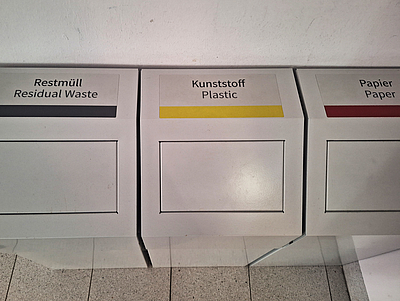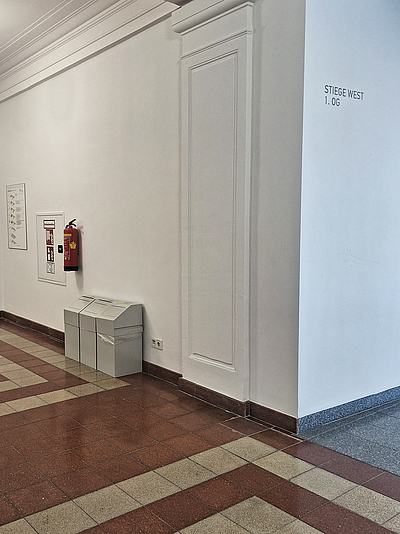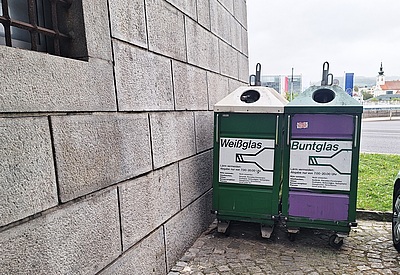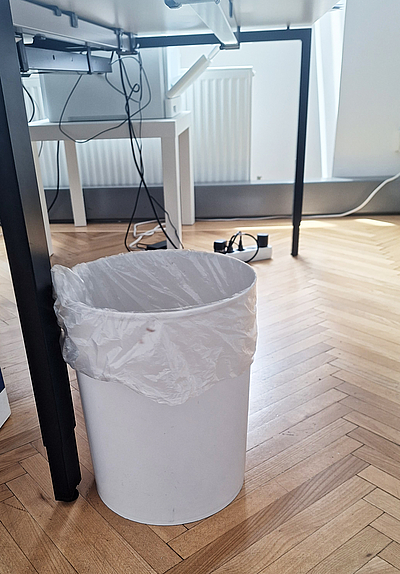Waste prevention and separation
at the University of Arts Linz
A university produces a lot of waste every day. Each and every one of us can consciously avoid waste in our everyday work and study life and actively contribute to the protection of resources through conscientious waste separation. The following is a brief summary of how everyone can get active.
Preventing waste
The basic principle is: “The best waste is the waste that is not produced at all.” In line with the “reduce-reuse-recycle” principle, we can all make sure we produce less waste. This starts already with the little things: such as printing less or double-sided, using things for as long as possible or even reusing them.
Separate waste
Waste cannot be completely avoided. But we can all make an effort to dispose it properly every day. We currently have a 3-part separation system in our hallways (paper, plastic and general waste). If you are ever unsure about how to dispose an item or what belongs in which garbage container, Linz AG has provided online separation instructions and a waste ABC that can help if you are unsure.
Waste in the office
Most offices at the Kunstuni are equipped with a waste garbage bin. This is emptied daily by the cleaning staff. However, the cleaning staff do not have the time to sort this waste. We therefore ask all employees, for the protection of the environment, to make more use of the hallway separation systems for plastic, paper and general waste and not to dispose of everything in the office's own waste garbage bin. This can be easily integrated into everyday working routines: on the way to a meeting, coffee in the tea kitchen, on the way to lunch or on the way home, waste can be taken out of your own office and disposed of in the waste systems provided for this purpose. In this way, we are trying to reduce the amount of general waste we produce. Many people already collect their own paper waste separately in their offices and regularly take it to the sorting systems in the corridor or to the waste room - you are a role model for us and you can follow their example.
What to do with empty toner or printer cartridges? These can be handed in to the Wirtschaftsabteilung.
Waste separation systems
The Kunstuni provides waste separation systems in the corridors. On each floor of the HP6 and HP8 buildings there are 2 triple recycling bins for paper, plastic and residual waste. These are located near the elevator/atriums and are uniformly marked in two languages. They are emptied daily by the cleaning staff,sorted and disposed of in the containers in the waste rooms. In Domgasse, there are slightly older 4-compartment separation systems in the corridors, in which paper, plastic, residual waste and glass can be disposed of.
Garbage rooms
For larger waste disposal requirements, every employee/student has access to the waste rooms in the individual buildings. These are located in the basement or on the ground floor. Hauptplatz 6 (H6 U1 36), Hauptplatz 8 (H8K121), Domgasse 1 (DOEG45)
Colored and white glass waste garbage bins are located outside the HP6 location at the entrance to the Werkstätte (Adalbert-Stifter-Platz between the University and Generali). Large quantities of glass bottles and empty glass packaging can be disposed of there near the university. There is a colored glass container in the waste room of the HP8 building. In the Domgasse building, the waste containers for colored and white glass are located directly in the waste room. There is also a publicly accessible colored and white glass container in Kollegiumgasse near Domgasse.
Kitchen
In the individual staff and departmental tea kitchens there are different recyclable waste collectors; here it is also important to make an effort to separate waste by type if a separation system is available or to use the corridor separation systems. There is a general waste collection container in every team kitchen.
Be a role model
Each and every one of us can be a role model and advocate reduction and good separation when it comes to waste. For example, you can advocate for reusable drinks at events, joint cooking evenings or department meetings in your department or promote conscientious recycling. When clearing out offices and studios, greater attention can also be paid to disposing of waste by type. Single-origin waste can replace natural resources as secondary raw materials and contribute to climate protection. Something that is already commendably exemplified in many departments is the reuse and recycling of materials (e.g. wooden panels, slats, exhibition architecture). At the University of Art and Design, many exhibitions/events are set up and dismantled every year. This naturally results in an increased amount of waste. Here, too, each individual can set a good example and encourage all those involved to use the existing separation systems when separating waste or to strive for direct separation by type in the waste rooms.
The University is trying to improve its waste management. Many requests and suggestions for improvement have already been submitted and attempts will be made to implement some of them in the years ahead. Nevertheless, we can all make a contribution right now and make a daily effort to avoid waste and separate our waste as best we can.



